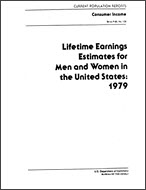Lifetime Earnings Estimates for Men and Women in the United States: 1979
Lifetime Earnings Estimates for Men and Women in the United States: 1979
Introduction
Almost everyone has asked themselves at one time or another, "How much money will I make in my lifetime?" Most have probably attempted to estimate this amount by multiplying their current annual earnings or some expected annual earnings by the number of years they plan to work. Using a more sophisticated approach this report presents estimates of expected lifetime earnings based on data collected in the March Current Population Survey (CPS). These expected lifetime earnings data, while somewhat speculative in nature, provide a scientific basis for examining expected future earnings at specified ages and differences in future earnings at various educational attainment levels.
While the Bureau of the Census has published expected lifetime earnings and income estimates in the past (the latest report issued in 1974 was Current Population Reports, Series P-60, No. 92), this report differs from these previous efforts in several respects. First, estimates of annual rates of employment by age have been incorporated into the procedures. Introduction of these probabilities of employment have improved on past estimation techniques since in past studies these employment rates were assumed to be 100 percent for all ages between 18 and 64 years. Second, estimates of the expected lifetime earnings for women were instituted for the first time. These estimates for women have been avoided in the past because their attachment to the work force is far less permanent than that of most men. However, because of widespread interest and numerous requests, we have developed estimates for women as well as for men. The reader is cautioned that the estimates for men and women are not directly comparable for a number of reasons, most of which are discussed later in this report.
The lifetime earnings estimates presented here are expected or average amounts based on cross-sectional earnings data by age, sex, and educational attainment for the years 1978, 1979, and 1980. Data for these three years were averaged in order to obtain a sample size large enough to support this study. The cross-sectional data reflect both current employment and earnings conditions and past social, demographic, and economic conditions that have led to the differences in earnings levels for persons of different ages, sexes, and educational attainment levels. Use of the cross-sectional earnings data assumes that current relationships are representative of the future. Therefore, the accuracy of these estimates is dependent on how closely these past trends reflect changes in the earnings levels over the next 50 years. The limitations section discusses the important assumptions required to develop these estimates and other considerations which should be noted before examining the data in detail.
A Note on Language
Census statistics date back to 1790 and reflect the growth and change of the United States. Past census reports contain some terms that today’s readers may consider obsolete and inappropriate. As part of our goal to be open and transparent with the public, we are improving access to all Census Bureau original publications and statistics, which serve as a guide to the nation's history.
Others in Series
Publication
Publication
Publication






